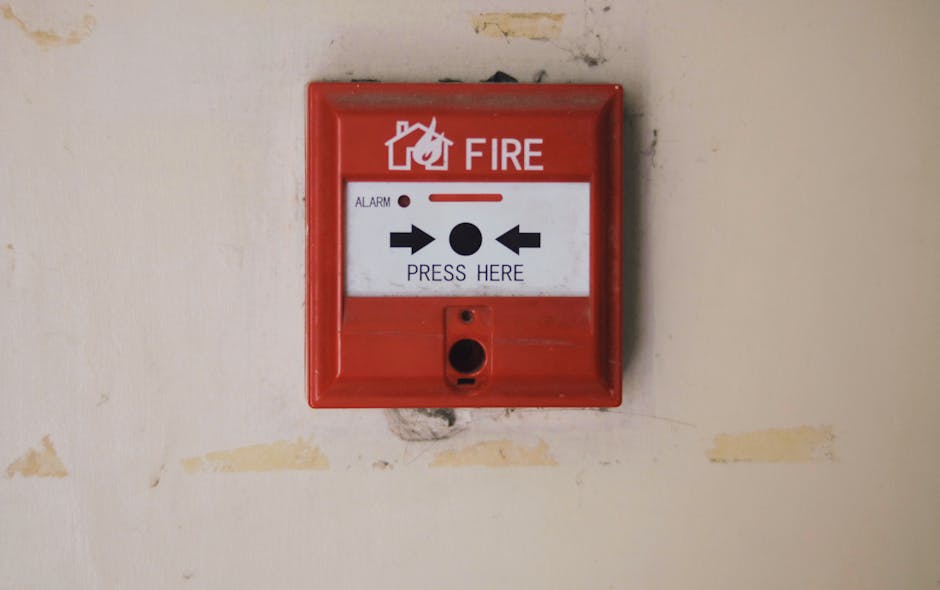- Introduction to Industrial Security and Modern Challenges
- Advancements in Smart Camera Technology
- Integrated Alarm Systems: Features and Benefits
- Implementation Strategies for Factories
- Case Studies: Successful Deployments in Industry
- Comparative Analysis: Traditional vs. Modern Surveillance
- Future Trends in Factory Surveillance Technologies
Introduction to Industrial Security and Modern Challenges
Industrial security is a critical component in ensuring the safety, efficiency, and sustainability of manufacturing and production facilities. As industries evolve, the importance of sophisticated surveillance systems becomes increasingly evident. Factories face numerous security challenges, ranging from theft and vandalism to unauthorized access and operational hazards. Modern security technologies, including smart cameras and integrated alarm systems, present comprehensive solutions to these challenges.
Today, industrial security entails more than traditional surveillance methods. The advent of digital transformation and the Industrial Internet of Things (IIoT) has spurred the development of advanced security systems. These new systems are designed to provide real-time monitoring, data analytics, and automated responses, thereby enhancing the overall security infrastructure of industrial environments.
A primary concern in industrial security is the protection of both human and material assets. According to the National Safety Council (NSC), workplace injuries in the manufacturing sector result in billions of dollars in direct and indirect costs annually. Effective surveillance systems can help mitigate these risks by providing visibility into operational areas and enabling prompt responses to incidents.
Another significant challenge is the threat of industrial espionage and cyber-attacks. A report by Cybersecurity Ventures projected that cybercrime damages will cost the world $6 trillion annually by 2021. This highlights the need for integrating cybersecurity measures with physical security systems to protect sensitive information and control networks.
The implementation of smart cameras and integrated alarm systems can address these concerns. Smart cameras are equipped with advanced features such as facial recognition, motion detection, and pattern analysis, which enhance their ability to monitor and secure industrial premises. On the other hand, integrated alarm systems provide a cohesive network that links various security devices, ensuring seamless communication and coordinated responses to potential security breaches.
Real-world examples demonstrate the efficacy of these technologies in improving industrial security. For instance, according to a study by MarketsandMarkets, the global market for video surveillance systems is projected to reach $77.21 billion by 2023, up from $45.5 billion in 2018. This growth underscores the increasing reliance on advanced surveillance technologies across various industries.
In summary, the landscape of industrial security is rapidly changing, driven by the need to protect assets, ensure operational safety, and counteract evolving threats. The adoption of smart cameras and integrated alarm systems represents a significant step forward in meeting these security challenges, offering comprehensive and efficient solutions tailored to the unique needs of modern industrial environments.
Advancements in Smart Camera Technology
In recent years, advancements in smart camera technology have significantly altered the landscape of industrial security. These innovations are reshaping how factories monitor and protect their assets, ensuring a safer and more efficient environment.
High Resolution and Low Light Capabilities
One of the significant advancements in smart camera technology is the improvement in image resolution. High-definition (HD) cameras offer clearer and more detailed images, allowing for better identification of individuals and objects. Moreover, many smart cameras now have enhanced low-light capabilities. With technologies such as infrared (IR) sensors and thermal imaging, these cameras provide clear footage even in poorly lit conditions, which is crucial for 24/7 surveillance.
Artificial Intelligence and Machine Learning
Artificial Intelligence (AI) has brought a transformative change in smart camera functionality. Cameras equipped with AI can perform real-time analysis and make decisions without human intervention. This includes recognizing faces, detecting unusual behaviors, and identifying potential threats. Machine learning algorithms allow these systems to improve over time, becoming more adept at distinguishing between false alarms and actual security incidents.
Enhanced Connectivity
Modern smart cameras benefit from enhanced connectivity options, such as Internet of Things (IoT) integration. This allows cameras to communicate with other devices and systems within the factory infrastructure. For example, an AI-enabled camera could trigger an alarm, notify the security team via mobile alerts, and start recording the incident simultaneously. Enhanced connectivity ensures a more responsive and coordinated security operation.
Cloud Storage and Edge Computing
Cloud storage solutions are increasingly being integrated with smart camera systems. This allows for secure, scalable storage of large volumes of video data, ensuring lossless, long-term archival of footage. Coupled with edge computing, smart cameras can process data locally to reduce latency and enhance real-time decision-making capabilities. Edge computing enables smart cameras to perform complex analytics tasks on-site, without relying solely on centralized cloud servers.
Integration with Other Security Systems
Today’s smart cameras can be integrated seamlessly with other security systems such as access control and alarm systems. This offers a unified security infrastructure that enhances situational awareness and response times. For instance, if a security breach is detected by an access control system, nearby smart cameras can be programmed to focus on the breach location and alert security personnel.
- Improved image resolution and low light capabilities for better surveillance.
- AI and machine learning for real-time analysis and threat detection.
- IoT integration for enhanced connectivity and coordinated security operations.
- Cloud storage and edge computing for secure, scalable, and efficient data processing.
- Seamless integration with other security systems for comprehensive protection.
Overall, the advancements in smart camera technology are revolutionizing industrial security, offering capabilities that go beyond traditional surveillance methods. Factories equipped with these technologies can achieve a higher level of safety and operational efficiency, safeguarding their assets and personnel against a range of threats.
Integrated Alarm Systems: Features and Benefits
Integrated alarm systems play a critical role in enhancing industrial security. These systems are designed to provide real-time alerts, enabling quick responses to potential threats. With the advent of technology, integrated alarm systems have evolved to incorporate various advanced features that benefit factory surveillance immensely.
One of the notable advancements is the seamless integration of alarm systems with smart cameras. This combination not only allows for real-time monitoring but also enhances the accuracy of threat detection. For instance, modern alarm systems are now capable of distinguishing between different types of movements, reducing the chances of false alarms. This level of precision is particularly valuable in an industrial setting where false alarms can disrupt operations and incur costs.
True Protection, a leading security system provider with five locations across Texas including Austin, San Antonio, Houston, Dallas/Fort Worth, has been at the forefront of providing customized security solutions to fit a wide range of needs. Their alarm systems are designed to integrate effortlessly with smart cameras, creating a robust surveillance network. This integration allows for features such as remote monitoring, where factory managers can oversee operations from anywhere, at any time, using mobile devices.
The benefits of integrated alarm systems extend beyond mere surveillance. They include:
- Improved Response Time: Integrated systems provide instant alerts to security personnel and local authorities, ensuring that threats are addressed promptly.
- Cost Efficiency: By reducing the number of false alarms, integrated systems help in lowering overall operational costs.
- Scalability: These systems can be easily scaled to accommodate the growing needs of a factory. Whether it’s a small business or an enterprise solution, customization is readily available.
- Comprehensive Coverage: Integration with advanced sensors and analytics ensures that every corner of the factory is monitored effectively.
Award-winning company True Protection offers great deals on the latest security and surveillance systems, providing homes, small businesses, and enterprise solutions. Their team of local experts ensures that the best security system is selected based on individual requirements, thus maximizing the benefits of integrated alarm systems.
In conclusion, the integration of alarm systems with smart cameras revolutionizes factory surveillance by enhancing detection accuracy, reducing costs, and providing scalable, comprehensive security solutions tailored to the specific needs of any industrial environment.
Implementation Strategies for Factories
Implementing smart cameras and integrated alarm systems in factories requires a strategic approach to ensure efficacy and cost-effectiveness. The integration process spans several critical steps, starting with a comprehensive security assessment, followed by meticulous planning, and culminating in detailed execution. Adopting the right methodology can significantly enhance the surveillance system’s performance and reliability.
The first step in the implementation strategy is conducting a comprehensive security assessment of the factory. This involves identifying key areas vulnerable to security breaches and understanding the specific requirements of the facility. A thorough evaluation helps tailor the surveillance system to address the unique challenges of the factory environment. Security consultants or internal security teams often perform these assessments to pinpoint potential risks and determine the optimal placement of smart cameras and sensors.
Following the assessment, the next phase is planning the integration. This involves choosing appropriate technology and designing a robust system architecture. Factors such as system scalability, compatibility with existing infrastructure, and future-proofing are crucial during this phase. Factories should select smart cameras and alarm systems that support features like advanced motion detection, facial recognition, and seamless data integration. Planning also encompasses network considerations, ensuring the surveillance system operates without latency issues and integrates smoothly with other security protocols.
After planning, the focus shifts to the installation and configuration of the smart cameras and integrated alarms. Proper installation is vital for effectiveness; hence, professional installation services are often recommended. During this phase, cameras are positioned strategically to cover critical areas without blind spots, while alarm systems are integrated to provide real-time alerts for any suspicious activity. This stage also includes configuring the software to optimize the performance of hardware components and aligning them with the facility’s security policies.
Training and ongoing maintenance are integral to successful system deployment. Security personnel need adequate training to operate and manage the new technologies effectively. This training ensures personnel can utilize the full capabilities of smart cameras and alarm systems, from live monitoring to data analysis. Ongoing maintenance, including regular software updates and hardware checks, ensures the long-term reliability and efficiency of the surveillance system.
Finally, continuous evaluation and improvement of the surveillance system is necessary to adapt to evolving security threats. Regular audits and performance reviews help in identifying any lapses or areas for improvement. This iterative process enables factories to upgrade their security systems dynamically, integrating newer technologies as they emerge and maintaining a steadfast security posture against both existing and new threats.
In summary, the implementation of smart cameras and integrated alarm systems in factories necessitates a detailed, multi-phase strategy. A meticulously planned and executed strategy ensures that factories can significantly bolster their security infrastructure, safeguarding assets, and ensuring operational continuity.
Case Studies: Successful Deployments in Industry
One notable example of successful deployment of smart cameras and integrated alarm systems is found in the automotive manufacturing sector. Auto manufacturers such as Ford have integrated advanced surveillance technologies to enhance the security of their production facilities. By leveraging smart cameras with AI capabilities and integrated alarm systems, they have significantly reduced theft and vandalism incidents. The implementation of these technologies has not only bolstered security but also optimized operational efficiency by ensuring smooth workflow and minimizing downtime.
The food and beverage industry has also benefitted from these advanced surveillance solutions. Companies like Nestlé have installed smart cameras and integrated alarms across their factories to ensure product safety and compliance with industry standards. These surveillance and alarm systems help monitor critical control points and detect any anomalies in real-time, thus preventing potential contamination. The result is an enhanced security framework that supports food safety and quality control, ultimately protecting consumer health.
In the pharmaceutical industry, firms such as Pfizer have adopted integrated surveillance systems to safeguard drug manufacturing processes. Smart cameras with advanced analytics capabilities are used to monitor production lines, ensuring adherence to stringent regulatory requirements. These systems can detect unauthorized access and automatically trigger alerts, preventing potential security breaches. This deployment underscores the importance of maintaining high security standards to prevent tampering and ensure the integrity of pharmaceutical products.
The electronics manufacturing sector has also seen the benefits of these technologies, with companies like Samsung implementing smart surveillance solutions. By utilizing high-resolution cameras equipped with facial recognition and motion detection features, these companies can closely monitor their assembly lines. When combined with integrated alarms, any suspicious activity can be promptly addressed, thereby securing valuable assets and sensitive information. This approach enhances both physical and intellectual property security.
These real-world examples highlight the efficacy of integrating smart cameras and alarm systems within industrial sectors. Companies across various industries have successfully reduced security risks, improved compliance, and optimized their operational workflows through these advanced surveillance technologies.
Comparative Analysis: Traditional vs. Modern Surveillance
Comparing traditional surveillance methods to modern approaches involving smart cameras and integrated alarm systems showcases significant advancements in industrial security. Traditional surveillance systems typically rely on static CCTV cameras that record footage continually. These systems often require human operators to monitor feeds and identify potential security threats, leading to increased labor costs and potential inconsistencies due to human error.
In contrast, modern surveillance systems utilize smart cameras equipped with advanced technologies such as artificial intelligence (AI) and machine learning (ML). These smart cameras are capable of motion detection, facial recognition, and behavior analysis. By processing data in real-time, these systems can identify suspicious activities or unauthorized access automatically, reducing the dependency on human operators and enhancing the overall efficiency of security operations. According to a study by MarketsandMarkets, the AI-powered video analytics market is expected to grow from USD 4.10 billion in 2019 to USD 8.55 billion by 2023, highlighting the rapid adoption and value of these technologies.
Integrated alarm systems further amplify the capabilities of modern surveillance by incorporating multiple layers of security. These systems blend various sensors, such as infrared, vibration, and acoustic sensors, to detect intrusions and anomalies. When integrated with smart cameras, they offer a holistic security solution that provides instant notifications and alerts to security personnel, allowing for prompt responses. This amalgamation of technologies ensures that any potential threats are swiftly identified and mitigated.
Another distinguishing feature of modern surveillance systems is their ability to store and analyze large volumes of data efficiently. Traditional systems often rely on physical storage solutions, which can be cumbersome and prone to failures. In contrast, modern systems leverage cloud storage, providing scalable, reliable, and secure data management options. According to a report by Allied Market Research, the global cloud storage market for video surveillance is projected to reach USD 21.55 billion by 2027, driven by the desire for enhanced data accessibility and security.
Moreover, modern surveillance systems support remote monitoring capabilities. Security personnel can access live feeds and receive alerts on their mobile devices, irrespective of their location. This functionality ensures continuous surveillance and swift action, which is particularly beneficial for large industrial premises. The International Data Corporation (IDC) predicts that by 2025, approximately 75% of enterprise-generated data will be processed outside traditional data centers or cloud infrastructures, emphasizing the trend towards distributed and remote data management solutions.
In summary, modern surveillance systems offer numerous advantages over traditional methods, including automated threat detection, integrated and multi-layered security, efficient data storage and analysis, and remote monitoring capabilities. These advancements not only bolster security but also enable industrial facilities to operate more securely and efficiently.
Future Trends in Factory Surveillance Technologies
As industrial security continues to evolve, the integration of advanced surveillance technologies presents numerous opportunities for enhancing factory safety and operational efficiency. Emerging trends in factory surveillance emphasize the importance of seamless integration, real-time data analysis, and adaptive technologies.
AI and Machine Learning
Artificial Intelligence (AI) and machine learning are poised to play a crucial role in the future of factory surveillance. These technologies enable smart cameras to analyze vast amounts of data quickly and accurately, identifying patterns and anomalies that may indicate security threats or operational inefficiencies. AI can also assist in predictive maintenance by monitoring equipment conditions and foreseeing potential failures.
IoT Integration
The Internet of Things (IoT) is transforming factory surveillance by enabling devices to communicate and share data autonomously. IoT integration facilitates the creation of interconnected systems where smart cameras, sensors, and alarm systems can work together seamlessly. This interconnected network enhances real-time monitoring and allows for more efficient incident response.
Cloud Computing
Cloud-based solutions are becoming increasingly popular for managing surveillance data. Storing and processing data in the cloud offers several advantages, including scalable storage, enhanced data security, and remote access. Cloud computing also supports advanced analytics and machine learning algorithms, providing deeper insights into security and operational data.
Advanced Video Analytics
Future factory surveillance systems will likely feature sophisticated video analytics capabilities. These capabilities include facial recognition, license plate recognition, and behavior analysis. Such technologies help in identifying unauthorized individuals, tracking vehicle movements, and understanding employee behavior within the factory premises.
Cybersecurity Measures
With the increasing reliance on digital surveillance infrastructure, robust cybersecurity measures are essential to protect against cyber threats. Future trends will focus on enhancing cybersecurity protocols to safeguard sensitive data and ensure the integrity of surveillance systems. Measures may include advanced encryption, multi-factor authentication, and continuous monitoring for potential vulnerabilities.
Wireless and 5G Technologies
The deployment of wireless and 5G technologies is expected to revolutionize factory surveillance by enabling faster data transmission and reducing latency. These advancements allow for more flexible installation of surveillance equipment and support high-definition video streaming, contributing to more detailed and comprehensive monitoring solutions.
- Artificial Intelligence and Machine Learning: Enhance data analysis capabilities.
- IoT Integration: Enable seamless device communication.
- Cloud Computing: Offer scalable storage and advanced analytics.
- Advanced Video Analytics: Provide sophisticated recognition and behavior analysis.
- Cybersecurity Measures: Protect against digital threats.
- Wireless and 5G Technologies: Improve data transmission speed and flexibility.
These future trends in factory surveillance technologies promise to create safer, more efficient industrial environments. By leveraging the latest advancements, factories can significantly enhance their security protocols and operational workflows.



